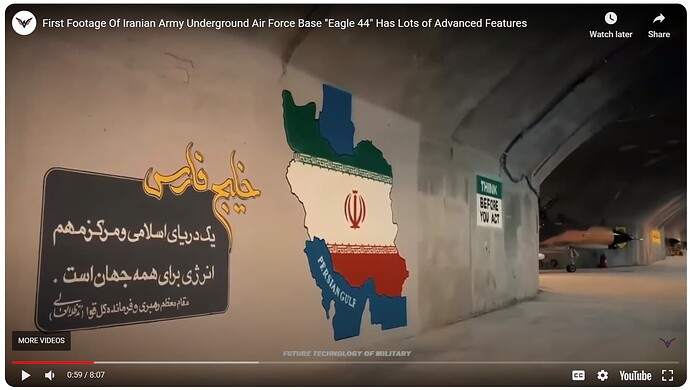When tunnels being dug but runway not started:
In its time, the Phantom was a formidable weapon. Nowadays, though, it is quite vulnerable to air-to-air or ground-to-air missiles. Not agile in a dogfight either.
Some years ago (pre-Covid, as we say), I was on a flight from Dubai that traversed Iran from east to west. Iran is a big country! One of the sights somewhere south of Qom was a long rocky ridge line sticking out of the desert. At regular intervals along this mountainside, concrete entryways had been constructed to … something. About 20 of them. The overall appearance was reminiscent of the nuclear weapons storage site one can see when flying out of Albuquerque, NM – but on a larger scale.
Iran has been digging in for years.
Assuming the location of the underground bunkers are known just significantly damaging the runway to the exit of these bunkers would temporarily trap the aircraft inside.
That was my first thought as well. What are the advantages of underground airfields, considering their construction can be monitored by satellite, thereby revealing their locations?
The International Atomic Energy Agency is trying to clarify how Iran accumulated uranium enriched to 84% purity — the highest level found by inspectors in the country to date, and a concentration just 6% below what’s needed for a weapon.
(Emphasis mine)
This is ignorant nonsense. Uranium enriched to 90% U-235 is called “weapons-grade”, but it is perfectly possible to make a bomb with uranium enriched well below this level: it just takes more uranium and a bigger bomb to hold the explosives to implode it. The “Little Boy” bomb dropped by the U.S. on Hiroshima used uranium enriched only to 80%, which with a good neutron reflector surrounding the pit works just fine. For 85% enriched uranium, the critical mass is 50 kg, which is a sphere 17 cm in diameter. In a boosted fission bomb, the tamper which is fissioned by the fast neutrons from the pit is often enriched to only between 40% and 80%.
Any enrichment beyond 20% is considered “highly enriched uranium”, because any enrichment above that is theoretically usable in an implosion bomb. Below 20%, critical mass grows rapidly, reaching infinity at 5.4% enrichment, so the 5% or less used in power reactors is considered safe from diversion to weapons.
For those who’d like to try this, themselves, at home, here is Fourmilab’s guide to “Uranium Enrichment”.

